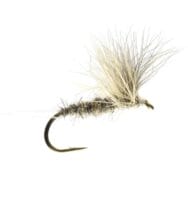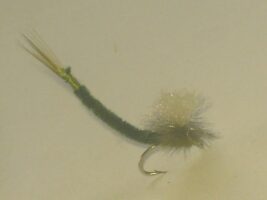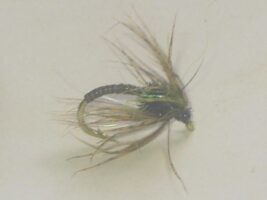Your cart is currently empty!
Grey Duster Fly
Historical Significance and Pattern Evolution The Grey Duster fly stands as one of fly fishing’s most versatile and enduring patterns, originating from Welsh rivers where it was first developed as a stillwater midge imitation. This classic pattern has evolved from its humble beginnings to become a staple in fly boxes worldwide, proving its effectiveness across…
Description
Historical Significance and Pattern Evolution
The Grey Duster fly stands as one of fly fishing’s most versatile and enduring patterns, originating from Welsh rivers where it was first developed as a stillwater midge imitation. This classic pattern has evolved from its humble beginnings to become a staple in fly boxes worldwide, proving its effectiveness across various fishing conditions and situations. Its simple yet effective design embodies the principle that sometimes less is more in fly fishing.
Premium Materials and Construction Details
Essential Materials List:
- Hook: Dry fly hook (sizes 12-18)
- Thread: Grey 8/0
- Tail: Badger cock hackle fibers (optional)
- Body: Grey fur dubbing
- Hackle: High-quality badger or grizzly cock hackle
- Wing: CDC or traditional hackle tips
- Optional: Fine silver wire for ribbing
- Head: Grey thread with clear finish
Material Selection Considerations:
- Hook quality affects flotation and durability
- Thread choice impacts body profile
- Hackle quality determines float characteristics
- Dubbing preparation affects body texture
- Wing material selection influences visibility
- Material preparation affects proportions
- Storage conditions preserve materials
- Handling techniques protect delicate items
- Organization systems maintain quality
- Inventory management ensures availability
Detailed Tying Instructions
Preparation Steps:
- Select appropriate hook size
- Choose quality hackle
- Prepare dubbing portions
- Select tail fibers if using
- Organize materials
- Check tools
- Plan proportions
- Review pattern
- Prepare workspace
- Test thread strength
Step-by-Step Tying Sequence:
- Start thread behind eye
- Create uniform thread base
- Tie in tail (if using)
- Apply dubbing to thread
- Form tapered body
- Tie in hackle
- Wind hackle forward
- Secure and trim hackle
- Build neat head
- Whip finish
- Apply head cement
- Check proportions
Advanced Fishing Techniques
Presentation Methods:
- Dead drift presentation
- Slight twitches
- Downstream drift
- Upstream presentation
- Cross-current fishing
- Edge water tactics
- Film fishing
- Current seam presentation
- Structure approaches
- Pattern combinations
Water Reading Skills:
- Identify feeding lanes
- Recognize current breaks
- Spot productive runs
- Detect surface activity
- Read water clarity
- Locate rising fish
- Find transition zones
- Identify temperature breaks
- Track fish movement
- Monitor insect activity
Seasonal Strategies
Spring Tactics:
- Match early hatches
- Focus on warming water
- Target active fish
- Adjust presentation
- Monitor temperatures
- Watch for rises
- Follow fish movement
- Time presentations
- Adapt to conditions
- Match natural drift
Summer Applications:
- Early morning fishing
- Late evening sessions
- Target shade lines
- Focus on riffles
- Match daily patterns
- Observe feeding windows
- Adjust to conditions
- Monitor water levels
- Watch temperatures
- Time presentations
Fall Approaches:
- Match late-season hatches
- Target feeding fish
- Adjust presentation style
- Watch water conditions
- Monitor temperatures
- Follow movement patterns
- Adapt to weather
- Time efforts effectively
- Match natural drift
- Adjust techniques
Technical Rigging Considerations
Leader Construction:
- Long, tapered leaders
- Quality tippet material
- Proper diameter selection
- Breaking strength considerations
- Length adjustments
- Material choices
- Knot selection
- Visibility factors
- Float characteristics
- Setup variations
Terminal Tackle:
- Tippet ring options
- Direct connection methods
- Leader construction
- Line control
- Strike detection
- Float adjustment
- Pattern spacing
- Drift control
- Presentation angles
- Setup modifications
Habitat-Specific Tactics
Water Types:
- Freestone streams
- Spring creeks
- Tailwaters
- Still waters
- Small brooks
- Large rivers
- Mixed waters
- Clear streams
- Stained water
- Technical water
Specific Locations:
- Riffles
- Pools
- Runs
- Seams
- Structure
- Banks
- Midstream
- Transitions
- Feeding lanes
- Back eddies
Advanced Presentation Methods
Traditional Techniques:
- Upstream dry fly
- Downstream presentation
- Cross-current drift
- Reach cast
- Pile cast
- Parachute cast
- Aerial mend
- Stack mend
- Curve cast
- Wiggle cast
Modern Adaptations:
- CDC wing variations
- Parachute style
- Emerger versions
- Multiple fly rigs
- Indicator techniques
- Film fishing methods
- Edge water tactics
- Structure approaches
- Pattern combinations
- Presentation modifications
Pattern Variations
Size Considerations:
- Match natural insects
- Consider water type
- Adapt to pressure
- Account for clarity
- Follow seasonal trends
- Consider fish size
- Match preferences
- Adapt to conditions
- Consider speed
- Match forage base
Style Variations:
- Traditional hackled
- CDC wing
- Parachute style
- Emerger version
- No-hackle variant
- Spent pattern
- Thorax style
- Comparadun style
- Film variant
- Low-floating version
The Grey Duster represents the perfect combination of traditional design and practical effectiveness. Its carefully selected materials and precise construction ensure consistent performance across various fishing conditions. Whether targeting selective trout during specific hatches or searching for opportunistic feeders, this pattern provides the perfect tool for successful dry fly fishing throughout the season
Additional information
| Hook size | 10, 12, 14, 16, 18, 20, 22 |
|---|---|
| Hook type | Barbed Hooks, Barbless Hooks |







